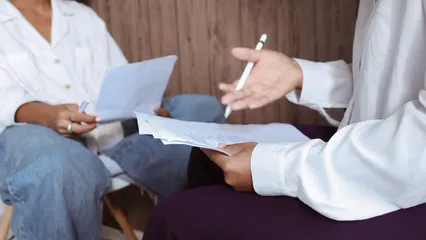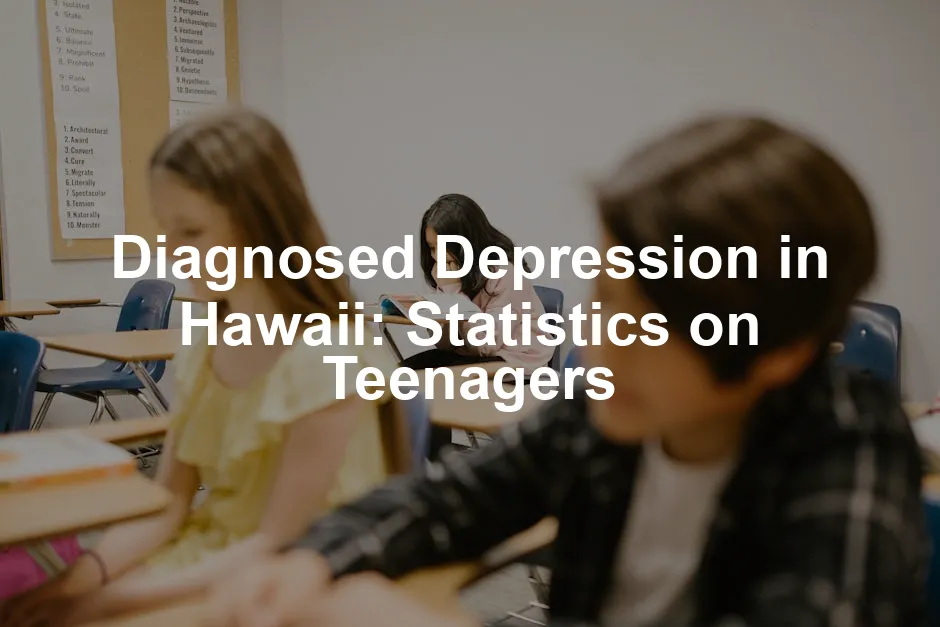Introduction
In recent years, diagnosed depression among teenagers in Hawaii has become a pressing issue. Understanding this topic is vital as it significantly impacts the well-being of our youth. The alarming rise in mental health issues is a concern for parents, educators, and policymakers alike.
Key statistics reveal a troubling picture. Approximately 11,000 youths in Hawaii experienced at least one major depressive episode (MDE) in the last year, representing about 11.97% of the population. This figure is slightly below the national average of 13.1%. However, this number has risen due to various factors, including the COVID-19 pandemic and increasingly challenging socio-economic conditions.
The pandemic has intensified feelings of isolation and anxiety among adolescents. School closures and the abrupt shift to online learning disrupted routines and support systems, leaving many teenagers struggling to cope. The combination of stressors has led to a marked increase in mental health issues. In fact, reports indicate a staggering 23% rise in the number of children facing anxiety and depression from 2016 to 2020.
Recognizing these statistics is crucial. Parents need to understand the signs of depression in their children to provide support. Educators must implement programs that promote mental health awareness. Policymakers should prioritize funding for mental health services in schools and communities. Awareness, education, and intervention can make a significant difference in treating and preventing depression among Hawaii’s youth.

For a deeper understanding of the factors influencing mental health, consider exploring an introduction to statistical learning with Python, which discusses the importance of understanding data in various contexts.
Understanding Depression
Overview of Depression
What exactly is depression? It’s a serious mood disorder that impacts how a person feels, thinks, and handles daily activities. Major Depressive Disorder (MDD) is the most common form, characterized by persistent sadness and a loss of interest in previously enjoyed activities. This condition is more than just a temporary feeling of sadness; it can disrupt a teenager’s life significantly.
It’s essential to differentiate between clinical depression and temporary sadness. While everyone experiences moments of sadness, clinical depression persists. It can affect a teenager’s ability to function in school, maintain friendships, or even enjoy hobbies. Recognizing this distinction is crucial for timely intervention.
Signs and Symptoms
Teenagers may exhibit various symptoms if they are struggling with depression. Common signs include persistent sadness, irritability, and a loss of interest in activities they once enjoyed. Additional symptoms might be fatigue, difficulty concentrating, and changes in sleep patterns.
In Hawaii, recent surveys have shown that a significant number of teenagers report these symptoms. For instance, nearly 34.8% of high school students experienced feelings of sadness lasting two weeks or more. The prevalence of these symptoms highlights the urgent need for awareness and support for mental health among Hawaii’s youth.
Understanding these signs can facilitate early intervention, allowing parents, teachers, and friends to provide the necessary support before the situation worsens.
If you’re looking for a practical guide to understand and manage depression, consider reading The Mindful Way Through Depression. This book offers insightful techniques to help individuals free themselves from chronic unhappiness, making it an essential read for those seeking to understand their emotions better.

Risk Factors
Teen depression in Hawaii has many influencing factors. Understanding these can help us tackle this growing issue.
Genetic Predisposition: If depression runs in the family, teens may face a higher risk. Genetics plays a crucial role in mental health. Kids with a family history of depression are at greater risk. It’s like inheriting the family’s knack for sarcasm, but unfortunately, it comes with a side of sadness.
Environmental Stressors: Hawaii’s beautiful landscapes can’t shield our teens from life’s pressures. Factors like bullying, academic expectations, and family issues can weigh heavily on a young mind. In Hawaii, the culture of “ohana” (family) can sometimes lead to high expectations. When teens feel they are not measuring up, it can result in feelings of worthlessness.
Social Media Impact: Social media is a double-edged sword. While it connects us, it also fosters comparison. A recent survey indicated that over 60% of teens in Hawaii feel pressured by social media to present a perfect life. This constant comparison can lead to feelings of inadequacy and depression.
Statistics: Studies focusing on Hawaii’s youth demographics reveal staggering insights. For instance, around 34.8% of high school students reported persistent feelings of sadness. Additionally, the 2022 KIDS COUNT Data Book highlighted a 23% increase in anxiety and depression among children from 2016 to 2020. These figures underscore the importance of addressing these risk factors head-on.
By understanding these influences, we can better support our teens in navigating their emotional landscapes. Awareness is the first step towards making meaningful changes.

Access to Mental Health Services
In Hawaii, a striking 57.9% of teenagers who needed mental health services did not receive them. That’s a lot of young people feeling lost and unsupported. Why? There are several barriers standing in their way.
Stigma plays a massive role. Many teens worry about being labeled as “crazy” if they seek help. This fear often keeps them from reaching out, even when they feel overwhelmed. Additionally, the lack of available resources complicates matters. With a shortage of mental health professionals, many teens find themselves in a waiting game for support.
Many schools lack adequate mental health programs, further exacerbating the issue. These barriers create a perfect storm, leaving our youth struggling in silence. It’s essential to create an environment where seeking help is seen as a strength, not a weakness.
The Impact of Socioeconomic Factors
Educational and Economic Well-Being
Economic challenges in Hawaii significantly impact the mental health of teenagers. The cost of living is notoriously high, especially housing. Many families struggle to make ends meet. This financial strain leads to increased stress and anxiety for both parents and children. According to the 2022 KIDS COUNT Data Book, Hawaii ranks 34th in economic well-being. That’s a troubling statistic for a state known for its beauty and paradise-like lifestyle.
Unemployment rates also contribute to the economic instability affecting our youth. With fewer job opportunities available, teenagers are left feeling hopeless and demoralized. We can’t ignore the fact that a whopping 37% of children live in families that spend over one-third of their income on housing. When basic needs are hard to meet, mental health often takes a backseat.
Moreover, in the realm of education, Hawaii ranks 35th nationally. A staggering 72% of eighth graders scored below proficient in math. The pressure to perform academically can be overwhelming for teenagers, adding to their mental health struggles.

Policy Implications
Addressing mental health issues among Hawaii’s youth requires a multi-faceted approach. One crucial aspect is integrating mental health support into schools. Schools are where children spend a significant amount of their time. Legislative efforts must prioritize funding for mental health programs in educational settings.
Recent proposals aim to enhance mental health services in schools. This could involve hiring more counselors, implementing mental health education, and creating safe spaces for students to talk about their feelings.
Communities also play a vital role. Local organizations can help bridge the gap by providing resources and support networks. Advocates are urging lawmakers to consider these initiatives seriously. It’s clear that investing in mental health is not just a nicety—it’s a necessity.
In conclusion, Hawaii’s youth face a unique set of challenges that impact their mental health. From economic struggles to access barriers, the situation calls for urgent action. By prioritizing mental health in schools and communities, we can create a brighter, healthier future for our young people.

Treatment and Support Options
Addressing diagnosed depression in teenagers requires a multi-faceted approach. In Hawaii, various treatment options and community resources are available to support our youth. Let’s explore some of these avenues.
Available Treatments
1. Medications
Antidepressants can play a pivotal role in treating depression. These medications help balance chemicals in the brain that affect mood. However, finding the right medication can be a bit like dating—sometimes you have to go through a few bad matches before finding “the one.” It’s essential for teenagers to work closely with a healthcare professional to understand potential side effects and the expected duration of treatment.
2. Psychotherapy and Counseling
Therapy is often a cornerstone of effective treatment for depression. Various types of psychotherapy, including cognitive-behavioral therapy (CBT) and interpersonal therapy, can help teenagers identify and change negative thought patterns. Think of it as a mental tune-up—helping them shift gears and navigate life’s challenges more smoothly. Encouragingly, many teens have found that talking to a therapist makes them feel less alone and more understood.
3. School-Based Mental Health Programs
Schools in Hawaii are increasingly recognizing the importance of mental health support. Many institutions offer school-based programs that provide counseling services and mental health education. These programs not only help students access support conveniently but also promote awareness and understanding of mental health issues among peers. After all, mental health shouldn’t be a taboo topic—it’s just as important as physical health!

For those looking to enhance their mental wellness, consider incorporating Aromatherapy Essential Oils Set into your routine. These oils can create a calming atmosphere, which is beneficial for mental health and relaxation.
Community Resources
Hawaii offers a wealth of community resources to support teenagers struggling with depression. Here are some noteworthy options:
- Hawai‘i CARES: This 24/7 crisis hotline provides immediate support for individuals in need. Whether it’s a late-night worry or a crisis situation, help is just a call away.
- Mental Health America of Hawai‘i: This organization offers resources, support groups, and educational programs tailored for youth. They aim to empower teens with knowledge and coping skills to manage their mental health.
- Help Your Keiki: This initiative provides resources specifically designed for parents and caregivers. It focuses on equipping families with the tools they need to support their children’s mental health journey.
- Online Therapy Platforms: With the rise of telehealth, several online therapy services are accessible to Hawaii’s youth. This option is especially beneficial for teens who may feel more comfortable seeking help from the comfort of home.
- Local Support Groups: Regularly scheduled support groups can provide a safe space for teenagers to share their experiences and feelings. It’s reassuring to know that they’re not alone in this battle.
- Youth Services and Organizations: Various local organizations, like the YMCA and Boys & Girls Clubs, offer programs that promote mental wellness through activities and social engagement. Finding a community can be a game changer!

These treatment options and resources illustrate that while the journey through depression can be daunting, support is available. Encouraging teens in Hawaii to seek help and utilize these resources can pave the way for healing and recovery. The more we talk about mental health, the more we can reduce stigma and create a supportive environment for our youth.
FAQs
What are the signs of depression in teenagers?
Identifying depression in teenagers can be tricky. Adolescents often mask their feelings, making it hard for parents and friends to notice. Here’s a comprehensive list of symptoms to watch for: Persistent sadness or low mood, Feelings of hopelessness or pessimism, Irritability or anger, Loss of interest in activities once enjoyed, Fatigue or decreased energy, Trouble concentrating or making decisions, Changes in sleep patterns (insomnia or oversleeping), Changes in appetite or weight, Physical symptoms without a clear cause (like headaches), Thoughts of death or suicide, Withdrawal from friends and family, Decline in academic performance. In Hawaii, nearly 34.8% of high school students reported experiencing these feelings. It’s essential to recognize these signs early to facilitate timely intervention.
How can parents help their teenagers struggling with depression?
Parents can play a crucial role in supporting their teenagers through tough times. Here are some practical tips for effective support: 1. Open Communication: Create a safe space for open dialogue. Encourage your teen to share their feelings without fear of judgment. Ask questions that show genuine interest and concern. 2. Listen Actively: When your teen talks, listen attentively. Validate their feelings and avoid minimizing their emotions. Sometimes, they just need someone to hear them out. 3. Encourage Professional Help: Don’t hesitate to suggest seeking help from a mental health professional. Therapists can provide coping strategies tailored to your teen’s needs. 4. Educate Yourself: Learn about depression and its effects on teens. Understanding the condition can help you respond better and provide the support your child needs. 5. Promote Healthy Habits: Encourage a balanced lifestyle with regular exercise, healthy eating, and sufficient sleep. Physical health can significantly impact mental well-being. 6. Limit Screen Time: Encourage breaks from social media. Excessive screen time can increase feelings of anxiety and depression. By taking these steps, parents can help their teenagers feel supported and understood during challenging times.
What resources are available for teenagers in Hawaii?
Hawaii offers various resources for teenagers facing mental health challenges. Here are some local and online options: 1. Hawai‘i CARES: A 24/7 crisis hotline providing immediate support. Just call 1-800-753-6879 for help. 2. Mental Health America of Hawai‘i: Offers educational programs and resources for youth and families, focusing on mental health awareness and support. 3. Help Your Keiki: A resource aimed at parents and caregivers to help children manage their mental health effectively. 4. School Counseling Services: Many schools in Hawaii provide counseling services. Check with your teen’s school for available support. 5. Online Therapy Platforms: Telehealth services are increasingly available, making it easier for teens to access therapy from the comfort of home. 6. Support Groups: Local organizations often host youth support groups. Sharing experiences with peers can foster connection and understanding. These resources aim to empower Hawaii’s youth and provide the necessary support to navigate mental health challenges.
How does Hawaii compare to other states regarding teen depression rates?
Hawaii’s statistics on teen depression are concerning yet provide some context in comparison to national averages. Here’s a quick look: Approximately 11.97% of Hawaii’s youth have experienced at least one major depressive episode (MDE) in the past year, slightly below the national average of 13.1%. In 2021, around 34.8% of high school students reported persistent feelings of sadness, indicating a significant mental health challenge. The 2022 KIDS COUNT Data Book showed a 23% increase in children struggling with anxiety and depression from 2016 to 2020. This data highlights the need for continued support and resources for mental health in Hawaii, especially given the rising rates of depression among teenagers.
What role does social media play in teenage depression?
Social media is a double-edged sword for teenagers’ mental health. While it offers connection, it also fosters comparison and unrealistic expectations. Here’s how it impacts mental well-being: Increased Anxiety: A staggering 60% of teens feel pressured by social media to showcase a perfect life. This constant comparison can lead to anxiety and feelings of inadequacy. Cyberbullying: Online harassment can exacerbate feelings of isolation and depression. Victims may struggle with self-image and report higher levels of distress. Addictive Behavior: Excessive time spent on social media can lead to withdrawal from real-life interactions, increasing feelings of loneliness. Research Findings: Studies indicate that teens who spend more than three hours daily on social media are more likely to report mental health issues, including anxiety and depression. Encouraging balanced social media use and promoting healthy online habits can help mitigate these negative effects.
Please let us know what you think about our content by leaving a comment down below!
Thank you for reading till here 🙂
For additional support, consider using a Weighted Blanket for Anxiety Relief. It can provide comfort and a sense of security during stressful times.
If you’re looking for a way to relax and unwind, try out an Essential Oil Diffuser. Aromatherapy can significantly enhance your mood and promote relaxation.
For those who enjoy expressing themselves creatively, an Adult Coloring Book: Stress Relieving Patterns can be a wonderful outlet for stress relief.
Lastly, if you enjoy journaling, a Journaling Set for Mental Health can help you reflect and process your thoughts better.
All images from Pexels




